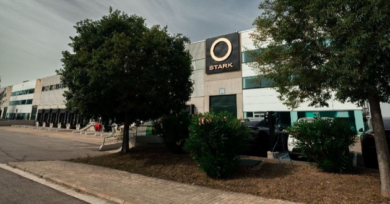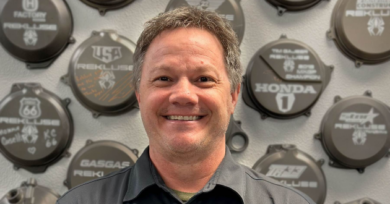Jan. 19, 2009 – A Survivor’s Tale
NEW ORLEANS — Friday, Aug. 26, 2005. It wasn’t even supposed to be a threat. Early news reports had it located hundreds of miles to the east. Out of sight, out of mind for Steve and Gayle Materne, owners of a New Orleans powersports dealership. “Friday night we’re leaving a party,” said Gayle Materne, “and everybody is around the TV and saying, ‘This hurricane is coming right at us.’ And we’re like, ‘What?’”
It had not only turned west, it turned savage. Using the warm waters of the Gulf of Mexico like an energy drink, the re-energized system seemed big enough on TV weather maps to devour entire sections of the South. The swirling, raging system came west, then eventually north. Toward New Orleans, and the warehouse housing Vespa New Orleans. The Maternes and hundreds of thousands of others fled.
Monday, Aug. 29, 2005. Hurricane Katrina hits. Brutally. Winds reach 150 mph. Rains pelt the Louisiana coastline so hard that more than an inch accumulates every hour. Worse,
50 miles east of the mouth of the Mississippi River, a wave reaching 55 feet high passes a buoy. The fateful floodwaters are coming.
Tuesday, Aug. 30, 2005. The bowl-shaped city of New Orleans, which mostly sits below sea level, is protected by a series of levees. This day, besieged by rain and floodwaters reaching up to 28 feet above normal tide levels, the levees fail to hold. Saltwater comes streaming in. Eighty percent of the city is consumed, with some water lying at depths of 20 feet high. The Maternes, like 500,000 other families, become refugees. Their house is unreachable and their business, a nationally known Vespa dealership, lies 6 feet underwater and remains in this toxic state for weeks.
How the Maternes overcame what was eventually called the most costly disaster to ever strike the United States is a real-life account of equal amounts daring, hard work and good fortune. It has, so many trying months later, miraculously lifted the family’s business from a small go-getter in the depths of New Orleans’ mid-city to become a neighborhood cornerstone, a shining example of recovery for a city still grappling with Katrina’s wrath.
The Drill
Preparing for the possibility of a hurricane was not new to the Maternes. They, after all, had been in the retail side of the powersports industry for a couple of years. They knew the drill. When a hurricane warning was issued, they would take their entire Vespa inventory, probably 50 or so scooters, and any consumers’ bikes that were being serviced — all of which could not be insured — to higher ground.
Mostly this daylong exercise proved futile as potential hurricanes either weakened into tropical storms or merely went in another direction. Perhaps for that reason the Maternes did not consider moving their inventory even after the Friday night party, waiting until the following morning to make the call.
It wasn’t the first time the family faced seeming disaster and went on with their business plans. Two days before 9-11, the Maternes received word from Piaggio that their nearly two-year quest to open a Vespa dealership had been granted.
It all started, strangely enough, because of a choir. The Maternes’ sons, Zach and Max, were part of a New Orleans boys choir that was asked to travel to Rome and perform for the Pope. This was in 1999.
“We took a trip over there and fell in love with Rome,” Gayle Materne said. “We saw scooters everywhere and thought that would be an amazing product to bring back to the city. So when we got home, we started researching the scooter industry.”
That led the Maternes to eventually reach out to Piaggio and file a dealer application.
“It was so Italian,” Gayle Materne recalled of the application. “You had to write a passionate essay on why you would be the best Vespa dealer. So we had a couple of glasses of Chianti,” she says, laughing, “and wrote this really passionate letter …”
By July 2002, the dealership opened in an old warehouse that the family had renovated.
“It looked bad on the outside, but it looked beautiful on the inside,” said Steve Materne.
“But it was so New Orleans,” Gayle Materne said. “There are a lot of places like that around here.”
Benefiting from a host of creative marketing ideas, the dealership thrived. Twice in the next three years, the store finished as one of the top Piaggio U.S. dealers in terms of sales volume. Business was so good the family eventually began looking to purchase a better location. They found it in September 2004 — a site comprised of two buildings, including one dating back to the 1930s that had housed a Packard auto dealer. The new site required renovation, which was started and within 30 days of completion when Katrina hit.
The Storm
On Saturday, Aug. 27, 2005, at 10 a.m. Central Time, the federal government’s National Hurricane Center issued a hurricane watch. The Maternes’ hesitancy all but vanished. They took their inventory of 80 Vespas and relocated them to higher ground.
“Had we not done that, we would not be here today,” Steve Materne said, alluding to the thousands of dollars the family would have had to pay lenders for the loss of inventory.
After moving the inventory, the Maternes packed up and drove to Houston, fleeing the hurricane. They were hardly alone. The usually six-hour-long trip took two or three times longer to complete in bumper-to-bumper traffic. The family arrived at a hotel in the early morning hours on Sunday, Aug. 26. Things turned decidingly worse the following day.
“That night, on the Internet, we heard the levees started breaking,” Gayle Materne said. “That was the end of the world.”
Or so they thought. The Maternes had always heard if the city flooded, it could take as long as six months to pump out the water. After all, flooding would result in a loss of electricity, which would make pumping water out nearly impossible.
“Once we heard the city was flooded, it was like what do we do now?” Gayle Materne said.
Going forward
Twenty-plus days. That’s how long parts of the city of New Orleans stood underwater before pumps finally disposed of the saltwater.
“They would let you come in (to the city) if you had a business and see and leave because at night time it was pitch dark,” Gayle Materne said. “There were no lights, no electricity. Just dismal.”
“It was scary. A lot of shooting,” Steve Materne said of the wave of crime that spread through the flooded city.
Besides finding their current dealership location underwater, the Maternes spent considerable time simply figuring out where to live. First, they lived with friends in Lafayette, La. Then, they began looking for a place to rent that was closer to home and where they could relocate their business.
“We knew if we let it go too long, a month, six weeks, we were going to lose our employees and our customers,” Steve Materne said.
It was a former customer, a city official in Baton Rouge, located about 70 miles away from New Orleans, who encouraged the Maternes to look for opportunities there. They did, but quickly found the biggest difficulty wasn’t finding a decent business location, but merely finding a place, any place, to rent.
“People thought they would never be able to come back home so they were buying up real estate,” Gayle Materne said. “There was this run of real estate.
“You would hear of a rental and you would get there and there would be 10 people there and one person would be saying, ‘I’ll buy it! I’ll buy it!’”
In fact, the Maternes were all but forced to buy a separate property their extended family had just rented. A day after moving in, their family was told to move out because somebody was purchasing the property.
While government officials were dealing with the aftereffects of Katrina, the Maternes were collecting payments and anxiety in equal measures. At one point, the family was paying mortgage on its New Orleans house and its new dealership location in New Orleans plus rent on its current flooded New Orleans warehouse, its new Baton Rouge house, its new Baton Rouge dealership location and a Baton Rouge warehouse for its scooter inventory. That’s to say nothing of the down payment they were forced to make on the house for their extended family.
“It was just overwhelming,” Gayle Materne said.
“I thought, this is nuts,” Steve Materne said. “This is crazy.”
Hard work and the relationship with their staff — three were living with them in Baton Rouge — paid off. The family relocated their entire Vespa inventory to the backyard of their new Baton Rouge house and in some measurable way, reopened their business. The backyard became the showroom and the garage was turned into a service area.
But largely, the Internet turned out to be a savior.
“We had just got our Web site up and we had been sending out newsletters so we were able to get in touch with our customers right away,” Gayle Materne said. “People were displaced and they had lost their scooters and they were in places that were packed with traffic, so they wanted to replace their scooters fast.”
For the Maternes, it was the turn of the tide.
A month to a day after Katrina savaged New Orleans, the Maternes sold their first scooter. By Nov. 1, with the considerable help of a Baton Rouge businessman, they had opened a new store.
In time, the Maternes also would learn the site they purchased and begun renovation on in New Orleans had, miraculously, been spared. Floodwaters had stopped halfway up the block on either side of them, even leaving 2 feet of water in a neighbor’s building. Workers returned to the site in November and finished the renovation and by February, some six months after Katrina, the new New Orleans dealership opened for business.
Business was brisk, with the Baton Rouge and New Orleans locations having a record year for unit volume.
The business boom, however, proved to be short-lived. The aftereffects of Katrina not only reared its head after rainstorms when the smell of saltwater would permeate the city, but well into a very long and depressing 2007.
“It was a real strange time in the city,” Gayle Materne said. “Things weren’t happening. People weren’t coming back. Nobody knew what to do just because of the decisions being made by the city. Everybody was kind of on hold and everybody got to this depression state mentality. They just didn’t want to spend money. They didn’t want to do anything.”
The reality of losing 200,000 homes, 220,000 jobs and 600 congregations had hit the city.
The Maternes, however, pressed on. With their sons Zach and Max now onboard and helping run the business, they added a motorcycle brand, Triumph, in late 2007 to build the consumer base. Sales rebounded tremendously in 2008, with Vespa sales again leading the way.
The city, in turn, has begun to show signs of a rebound. The population has begun to return and even the renowned streetcars have returned to prominent areas. On Jan. 9, 2009, a prominent New Orleans theater reopened bigger and better than ever. That same night, motorcycle and scooter enthusiasts came in waves to a special grand opening at the Maternes’ dealership, the Transportation Revolution. The store had just added a new brand, Ducati, and redesigned and enlarged their dealership.
Before dozens of consumers flocked around the Ducati Monsters, Steve and Gayle Materne reminisced about the monsters of Katrina. The uncertainties. The ballooning number of rent and mortgage checks the family had to endure.
“I don’t know how we’re going to get out of this mess,” Steve Materne recalled thinking at one point after Katrina came and went. “But we did. We worked our way out of it.”




